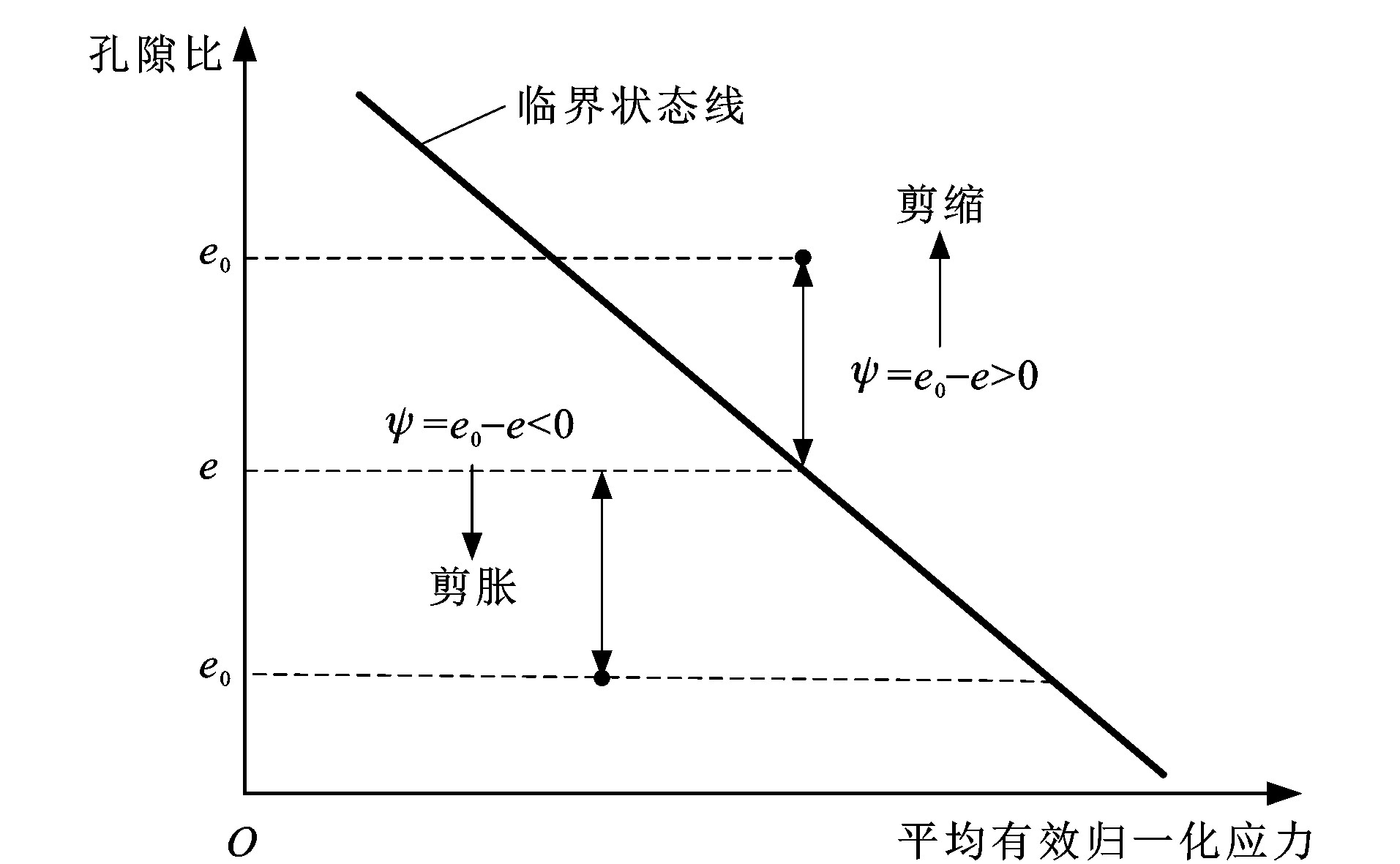Determining method of cohesionless soil state parameter based on resistivity CPTU and liquefaction evaluation
-
摘要: 为研究基于现场原位测试技术的状态参数评估新方法, 以宿迁—新沂高速公路工程为背景, 利用电阻率孔压静力触探对饱和无黏性土进行了现场原位测试; 参考已有原位测试状态参数计算法的均值, 联合电阻率与土类指数建立了状态参数计算方法; 利用该方法评估的状态参数进行液化评价。分析结果表明: 状态参数与土类指数呈正比关系, 而土类指数与电阻率呈反比关系, 土类指数可作为连接无黏性土状态性能和电学性能的有效指标之一; 建立的电阻率CPTU状态参数计算方法所评估的状态参数沿深度变化趋势与已有方法一致, 提出的电阻率CPTU状态参数评估法主要适用土类指数为1.8~2.6的粉土和粉砂; 根据电阻率CPTU法计算的无黏性土原位状态参数与相对密实度呈现良好的线性关系, 变化趋势相反, 可作为一种相对密实度常用指标的有效替代参数来进行土体密实状态的评估; 基于电阻率CPTU法计算的无黏性土原位状态参数评估的液化阻力比与国际通用法基本一致, 判别粉质砂土层8 m以下为液化层, 与标准贯入试验结果相符, 状态参数可有效地用于液化势的可靠判别。Abstract: In order to study a new method for evaluating the state parameter based on in-situ testing technology, the Suqian-Xinyi Expressway project was taken as the background, the in-situ test of saturated cohesionless soil was conducted by using the resistivity piezocone penetration test (CPTU). By referring to the mean values of the existing in-situ state parameter calculation methods in the literatures, the state parameter calculation method was established by combining the resistivity and soil behavior type index. The state parameter evaluated by the method was applied to the liquefaction evaluation. Analysis result shows that the state parameter is proportional to the soil behavior type index, while the soil behavior type index is inversely proportional to the resistivity and can be used as one of the effective indexes to connect the state and electrical properties of cohesionless soil. The trend of state parameter evaluated by the proposed calculation method of resistivity CPTU state parameters is in agreement with the values of the existing methods. The proposed resistivity CPTU method is mainly applicable to the silt and silty sand whose behavior type indexes are between 1.8 and 2.6. The in-situ state parameter of cohesionless soil calculated by the proposed method has good linear relationships with the relative density, the trend is opposite, and it can be used as an effective alternative parameter for the commonly used index of relative density to evaluate the compactness of soil. The liquefaction resistance ratio of cohesionless soil calculated based on the state parameter from the proposed method is basically consistent with the values of international general methods. It is concluded that the silty sand layer below 8 m is liquefaction layer, which is consistent with the standard penetration test results. The state parameter can be effectively used for the reliable discrimination of liquefaction potential.
-
表 1 影响土体电阻率相关因素汇总
Table 1. Summary of related factors affecting soil resistivity
相关变量 电阻率 影响程度 孔隙率 增加 ★★★ 饱和度 增加 ★★★ 盐浓度 增加 ★★★ 粒径 减小 ★★ 级配 增加 ★★ 温度 增加 ★★ 活性 增加 ★★ 表 2 原位测试CPTU状态参数确定方法汇总
Table 2. Summary of CPTU in-situ testing methods to evaluate state parameter
方法 公式 参数及其他说明 1 λ=1/ (34-10I1) 2 λ=F/10 3 ψ=0.56-0.33lg (Q1) 基于Been等提出的方法 4 电阻率CPTU状态参数计算方法 表 3 主要物理力学指标
Table 3. Main physico-mechanical indexes
名称 层厚/m 相对体积质量 细粒含量/% 含水量/% 液限/% 素填土 1.1 2.72 15.2 21.4 27.6 粉土 4.1 2.70 3.6 24.7 29.1 粉质砂土 9.8 2.69 5.2 29.8 28.4 粉土夹砂 未揭穿 2.68 5.7 27.2 29.8 -
[1] BEEN K, JEFFERIES M G. A state parameter for sands[J]. Géotechnique, 1985, 35 (2): 99-112. doi: 10.1680/geot.1985.35.2.99 [2] JEFFERIES M G. Nor-Sand: a simple critical state model for sand[J]. Géotechnique, 1993, 43 (1): 91-103. doi: 10.1680/geot.1993.43.1.91 [3] DAFALIAS Y F. Must critical state theory be revisited to include fabric effects?[J]. Acta Geotechnica, 2016, 11 (3): 479-491. doi: 10.1007/s11440-016-0441-0 [4] SABERI M, ANNAN C D, KONRAD J M, et al. A critical state two-surface plasticity model for gravelly soil-structure interfaces under monotonic and cyclic loading[J]. Computers and Geotechnics, 2016, 80: 71-82. doi: 10.1016/j.compgeo.2016.06.011 [5] WEI X, YANG J. A critical state constitutive model for clean and silty sand[J]. Acta Geotechnica, 2018, 13: 1-17. doi: 10.1007/s11440-017-0570-0 [6] GAO Zhi-wei, ZHAO Ji-dong, LI Xiang-song, et al. A critical state sand plasticity model accounting for fabric evolution[J]. International Journal for Numerical and Analytical Methods in Geomechanics, 2014, 38 (4): 370-390. doi: 10.1002/nag.2211 [7] 徐舜华, 郑刚, 徐光黎. 考虑剪切硬化的砂土临界状态本构模型[J]. 岩土工程学报, 2009, 31 (6): 953-958. doi: 10.3321/j.issn:1000-4548.2009.06.021XU Shun-hua, ZHENG Gang, XU Guang-li. Critical state constitutive model of sand with shear hardening[J]. Chinese Journal of Geotechnical Engineering, 2009, 31 (6): 953-958. (in Chinese). doi: 10.3321/j.issn:1000-4548.2009.06.021 [8] 赵成刚. 热动力学的稳态与非饱和土的临界状态[J]. 岩土工程学报, 2012, 34 (4): 730-733. https://www.cnki.com.cn/Article/CJFDTOTAL-YTGC201204024.htmZHAO Cheng-gang. Thermodynamic steady state and critical state for unsaturated soils[J]. Chinese Journal of Geotechnical Engineering, 2012, 34 (4): 730-733. (in Chinese). https://www.cnki.com.cn/Article/CJFDTOTAL-YTGC201204024.htm [9] 赵成刚, 尤昌龙. 饱和砂土液化与稳态强度[J]. 土木工程学报, 2001, 34 (3): 90-96. doi: 10.3321/j.issn:1000-131X.2001.03.016ZHAO Cheng-gang, YOU Chang-long. Liquefaction and steady state strength[J]. China Civil Engineering Journal, 2001, 34 (3): 90-96. (in Chinese). doi: 10.3321/j.issn:1000-131X.2001.03.016 [10] YANG J, LIU X, GUO Y, et al. A unified framework for evaluating in situ state of sand with varying fines content[J]. Géotechnique, 2017, 67 (2): 177-183. [11] DUAN Wei, CAI Guo-jun, LIU Song-yu, et al. Assessment of ground improvement by vibro-compaction method for liquefiable deposits from in-situ testing data[J]. International Journal of Civil Engineering, 2018, 4: 1-13. doi: 10.28991/cej-030964 [12] REID D. Estimating slope of critical state line from cone penetration test—an update[J]. Canadian Geotechnical Journal, 2015, 52 (1): 46-57. doi: 10.1139/cgj-2014-0068 [13] SHUTTLE D, JEFFERIES M G. Determining silt state from CPTU[J]. Geotechnical Research, 2016, 3 (3): 90-118. doi: 10.1680/jgere.16.00008 [14] BEEN K, JEFFERIES M G, CROOKS J H A, et al. The cone penetration test in sands: Part Ⅱ, general inference of state[J]. Géotechnique, 1987, 37 (3): 285-299. doi: 10.1680/geot.1987.37.3.285 [15] PLEWES H D, DAVIES M P, JEFFERIES M G. CPT based screening procedure for evaluating liquefaction susceptibility[C]//Canadian Geotechnical Society. Proceedings of the 45th Canadian Geotechnical Conference. Toronto: BiTech Publishers, 1992: 1-9. [16] ROBERTSON P K. Interpretation of cone penetration tests—a unified approach[J]. Canadian Geotechnical Journal, 2009, 46 (11): 1337-1355. doi: 10.1139/T09-065 [17] CAMPANELLA R G, KOKAN M J. A new approach to measuring dilatancy in saturated sands[J]. Geotechnical Testing Journal, 1993, 16 (4): 485-495. doi: 10.1520/GTJ10288J [18] WINDLE D, WROTH C P. Electrical resistivity method for determining volume changes that occur during a pressuremeter test[C]//ASCE. Proceedings of In Situ Measurement of Soil Properties. Reston: ASCE, 1975: 497-510. [19] JACKSON P D, SMITH D T, STANFORD P N. Resistivity-porosity-particle shape relationships for marine sands[J]. Geophysics, 1978, 43 (6): 1250-1268. doi: 10.1190/1.1440891 [20] 孔令明, 罗汀, 姚仰平. 率相关本构模型的临界状态描述[J]. 岩土力学, 2015, 36 (9): 2442-2450. https://www.cnki.com.cn/Article/CJFDTOTAL-YTLX201509003.htmKONG Ling-ming, LUO Ting, YAO Yang-ping. Description of critical state for rate-dependent constitutive models[J]. Rock and Soil Mechanics, 2015, 36 (9): 2442-2450. (in Chinese). https://www.cnki.com.cn/Article/CJFDTOTAL-YTLX201509003.htm [21] 黄茂松, 姚仰平, 尹振宇, 等. 土的基本特性及本构关系与强度理论[J]. 土木工程学报, 2016, 49 (7): 9-35. https://www.cnki.com.cn/Article/CJFDTOTAL-TMGC201607002.htmHUANG Mao-song, YAO Yang-ping, YIN Zhen-yu, et al. An overview on elementary mechanical behaviors, constitutive modeling and failure criterion of soils[J]. China Civil Engineering Journal, 2016, 49 (7): 9-35. (in Chinese). https://www.cnki.com.cn/Article/CJFDTOTAL-TMGC201607002.htm [22] RAHMAN M M, SITHARAM T G. Cyclic liquefaction screening of sand with non-plastic fines: critical state approach[J]. Geoscience Frontiers, 2018, 9: 1-10. [23] ARCHIE G E. The electrical resistivity log as an aid in determining some reservoir characteristics[J]. Well Logging Technology, 1942, 146: 54-61. [24] RINALDI V A, CUESTAS G A. Ohmic conductivity of a compacted silty clay[J]. Journal of Geotechnical and Geoenvironmental Engineering, 2002, 128 (10): 824-835. doi: 10.1061/(ASCE)1090-0241(2002)128:10(824) [25] 邹海峰, 刘松玉, 蔡国军, 等. 基于电阻率CPTU的饱和砂土液化势评价研究[J]. 岩土工程学报, 2013, 35 (7): 1280-1288. https://www.cnki.com.cn/Article/CJFDTOTAL-YTGC201307016.htmZOU Hai-feng, LIU Song-yu, CAI Guo-jun, et al. Evaluation of liquefaction potential of saturated sands based on piezocone penetration tests on resistivity[J]. Chinese Journal of Geotechnical Engineering, 2013, 35 (7): 1280-1288. (in Chinese). https://www.cnki.com.cn/Article/CJFDTOTAL-YTGC201307016.htm [26] WROTH C P. The interpretation of in situ soil tests[J]. Géotechnique, 1984, 34 (4): 449-489. doi: 10.1680/geot.1984.34.4.449 [27] 储亚, 蔡国军, 刘松玉. 基于CPTU原位测试状态参数的液化判别方法研究[J]. 地震工程学报, 2014, 36 (4): 905-910. doi: 10.3969/j.issn.1000-0844.2014.04.0905CHU Ya, CAI Guo-jun, LIU Song-yu. Study on liquefaction evaluation method based on state parameters of CPTU in situ measurement[J]. China Earthquake Engineering Journal, 2014, 36 (4): 905-910. (in Chinese). doi: 10.3969/j.issn.1000-0844.2014.04.0905 [28] JAMIOLKOWSKI M, PRESTI D C F L, MANASSERO M. Evaluation of relative density and shear strength of sands from CPT and DMT[J]. Soil Behavior and Soft Ground Construction, 2003 (119): 201-238. [29] YOUD T L, IDRISS I M. Liquefaction resistance of soils: summary report from the 1996 NCEER and 1998 NCEER/NSF workshops on evaluation of liquefaction resistance of soils[J]. Journal of Geotechnical and Geoenvironmental Engineering, 2001, 127 (4): 297-313. doi: 10.1061/(ASCE)1090-0241(2001)127:4(297) [30] BEEN K. Characterizing mine tailings for geotechnical design[J]. Australian Geomechanics Journal, 2016, 50 (4): 59-78. [31] SEED H B, IDRISS I M, ARANGO I. Evaluation of liquefaction potential using field performance data[J]. Journal of Geotechnical Engineering, 1983, 109 (3): 458-482. doi: 10.1061/(ASCE)0733-9410(1983)109:3(458) [32] JUANG C H, FANG S Y, KHOR E H. First-order reliability method for probabilistic liquefaction triggering analysis using CPT[J]. Journal of Geotechnical and Geoenvironmental Engineering, 2006, 132 (3): 337-350. doi: 10.1061/(ASCE)1090-0241(2006)132:3(337) -





 下载:
下载:














